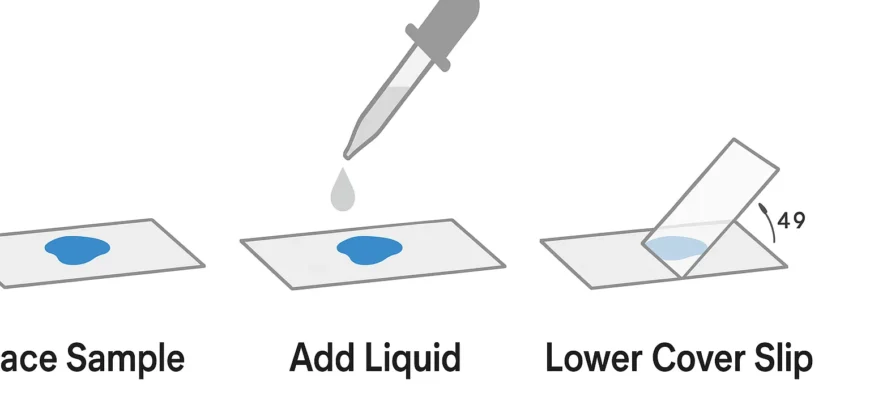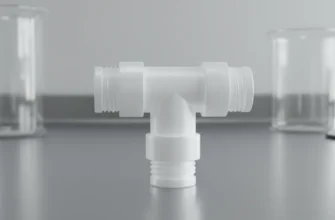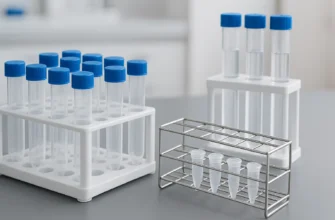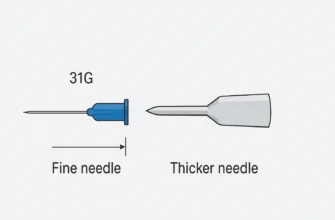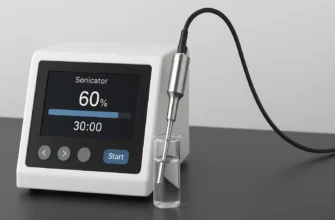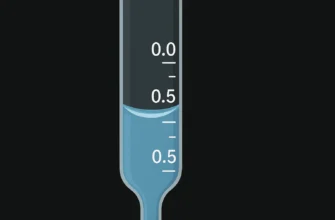Unlocking the Microscopic World
The world is teeming with intricate structures and vibrant life completely invisible to the naked eye. From the single-celled organisms in a drop of pond water to the complex architecture of our own cells, a hidden universe awaits discovery. The key to unlocking this microscopic world is the microscope, and the gateway is a properly prepared microscope slide. The field of microscopy is not just a niche hobby; it’s a cornerstone of science and medicine, with the global microscopy market valued at USD 9.7 billion in 2024 and projected to reach USD 13.3 billion by 2029, growing at a CAGR of 6.6%. Mastering the art of slide preparation is the first and most crucial step on any journey into the microscopic realm.
The Importance of Proper Slide Preparation
A common misconception is that the power of a microscope alone guarantees a clear image. In reality, the quality of your observation is almost entirely dependent on the quality of your slide. A poorly prepared sample can appear blurry, distorted, or completely obscured, regardless of how powerful your microscope is. Proper preparation ensures the specimen is flat, thin enough for light to pass through, and stable enough to be viewed without drifting or drying out. It is the foundation upon which all successful microscopic analysis is built.
What You’ll Learn in This Guide
This guide will walk you through everything you need to know to create high-quality microscope slides. We will cover the essential tools, master the fundamental mounting techniques for different types of samples, explore the basics of staining to enhance visibility, and provide step-by-step instructions for preparing common specimens. Finally, we will show you how to optimize your viewing experience and troubleshoot common problems, transforming you from a novice into a confident microscopist.
Essential Tools and Materials for Slide Preparation
Before you can begin, gathering the right equipment is essential. Having these items on hand will make the preparation process smooth, efficient, and successful.
Understanding the Microscope Slide: Types and Uses
The centerpiece of your preparation is the glass slide. Typically made from high-quality optical glass or corrosion-resistant clear sheet glass, a standard microscope slide measures 75mm x 25mm (approximately 3 x 1 inches) and is roughly 1mm thick. This standardized size ensures it fits the stage of any conventional microscope. The most common type is the plain slide or flat slide, a simple, clear rectangle of glass. Other variations include slides with frosted ends for easy labeling, which are particularly useful for permanent specimen identification.
Concave slides (also called depression slides or cavity slides) feature a small well or depression, typically 16mm in diameter and 0.5mm deep, designed to hold larger volumes of liquid specimens. These specialized slides are ideal for observing living samples such as pond water microorganisms, allowing them to move freely in their natural aqueous environment.
The Crucial Role of the Cover Slip (Cover Glass)
The cover slip, also known as cover glass or micro coverglass, is a very thin square or circle of glass or plastic placed over the specimen. Its functions are critical: it flattens the sample into a thin, even layer; it protects the specimen from the microscope’s objective lens; and it prevents the sample from drying out, particularly in a wet mount slide.
The standard thickness for cover slips is 0.17mm (designated as #1.5 or Number 1½ cover glass), which is the industry standard that microscope objectives are designed to accommodate. This precise thickness is essential for achieving optimal image quality. Cover slips ranging from 0.16-0.19mm (#1.5) or the more precise 0.17mm ± 0.005mm (#1.5H) are recommended for high-resolution work. Using incorrect coverslip thickness can cause spherical aberration and significantly reduce image quality, particularly with objectives having a numerical aperture (NA) greater than 0.4.
Necessary Instruments and Reagents
Beyond the slide and cover slip, you will need a few other tools. Forceps or tweezers are essential for handling specimens and carefully positioning cover slips. A pipette or eyedropper is needed for transferring liquids. For solid specimens, a dissecting needle or toothpick can help with positioning. You’ll need a mounting medium (often just distilled water for temporary preparations) and, for certain preparations, stain solutions such as methylene blue, iodine, or crystal violet. Having lens cloth or lens paper and cleaning solution nearby is also wise for keeping your slides and lenses pristine.
Mastering Basic Sample Mounting Techniques
Mounting is the process of securing a specimen onto a microscope slide. The technique you choose depends entirely on the nature of your sample. The three fundamental methods are the dry mount, the wet mount, and the smear mount.
The Dry Mount: Simplicity for Solid Samples
The dry mount is the simplest mounting technique, ideal for specimens that are already dry and thin, such as insect wings, hair, pollen, spider webs, or textile fibers.
How to Prepare a Dry Mount:
Ensure your microscope slide and cover slip are perfectly clean. Using forceps, carefully place the specimen in the center of the slide. Gently place a cover slip over the specimen. For very light specimens like pollen, the cover slip’s weight may be enough to hold it in place. For larger specimens, press down firmly to flatten the sample, as this is essential for achieving clear focus at higher magnifications. You can secure the edges of the cover slip with a tiny amount of clear nail polish or petroleum jelly if creating a more permanent mount.
The Wet Mount: Ideal for Living and Liquid Specimens
The wet mount (also called a wet-mount slide or temporary mount) is used for observing living samples (like bacteria or protozoa from pond water), liquid specimens, and any specimen that needs to be suspended in fluid to retain its structure.
How to Prepare a Wet Mount:
Place a clean glass slide on a flat surface. Add a single drop of liquid (distilled water, pond water, or a culture medium) to the center of the slide. Introduce your sample into the drop of liquid. If observing a solid specimen like onion skin or cheek cells, place it directly in the water.
Hold a cover glass at a 45-degree angle to the slide. Touch one edge to the edge of the water droplet. Slowly and gently lower the cover slip onto the water, allowing the liquid to spread gradually across the slide. This technique, which relies on surface tension, is crucial for minimizing or eliminating air bubbles, which can obstruct your view. If you have excess water, carefully blot the edges with a paper towel. To extend the life of your wet mount and prevent evaporation, you can seal the edges with petroleum jelly or clear nail polish.
The Smear Mount: For Dispersed Cells and Microorganisms
A smear or smear mount is used to create a thin, even layer of a viscous liquid or semi-solid sample, such as blood, yogurt, or bacterial samples. The goal is to separate the cells so they can be viewed individually.
How to Prepare a Smear Mount:
Place a small drop of the sample (e.g., blood for peripheral blood analysis) near one end of a clean slide. Take a second, clean slide (the “spreader” slide) and hold it at a 30-45 degree angle. Touch its edge to the first slide, just in front of the drop. Draw the spreader slide back until it makes contact with the drop, allowing the liquid to spread along its edge. In a single, smooth, and moderately fast motion, push the spreader slide forward to the other end of the sample slide. This action will drag the liquid behind it, creating a thin smear. A good smear will have a “feathered” edge. Allow the smear to air dry completely before staining or viewing.
Beyond the Basics: Introduction to More Advanced Mounting
While these three methods cover most amateur needs, professional laboratory settings employ more complex techniques. Section mounts involve embedding tissue samples in wax or other media, slicing them into incredibly thin sections with a microtome, and then mounting them – a process essential for fields like histology. The rapidly growing histology and cytology market, valued at USD 21.14 billion in 2024 and projected to reach USD 49.48 billion by 2030, underscores the importance of these advanced methods in diagnostics and research for examining connective tissue, nervous tissue, lymphoid system, exocrine glands, endocrine glands, and the urinary system.
The Art and Science of Staining Samples
Many biological specimens, especially individual cells, are almost transparent. Staining introduces color to specific cellular structures, creating contrast and making them visible under the microscope’s light.
Why Staining is Essential: Enhancing Visibility and Contrast
The cytoplasm, nucleus, and other organelles within a cell have very similar refractive indices, meaning light passes through them without much deviation. This results in a faint, low-contrast image. Stains are chemicals that bind to specific molecules within the cell (like DNA in the nucleus or proteins in the cytoplasm), coloring them and making them stand out sharply against their background.
Common Stains and Their Applications
There are hundreds of stains, each with a specific purpose. For beginners, a few are particularly useful:
Methylene Blue: A great all-purpose stain commonly used for animal cells (like cheek cells). It stains the nucleus a deep blue and is typically used at concentrations of 0.5% to 1%. Methylene blue stains negatively charged molecules in cells, including DNA and RNA.
Iodine Solution: Often used for plant cells. It turns starch granules a dark blue-black and makes the nucleus a yellowish-brown, increasing its visibility.
Crystal Violet: A powerful stain used in the Gram stains procedure to differentiate bacteria types. It imparts a deep purple color.
Wright’s Stain: A specialized stain used for hematology differential smears and blood smear analysis. Wright’s stain (or Wright-Giemsa stain) is prepared by dissolving Wright’s stain powder in methanol and is used to differentiate blood cell types. The staining reveals red blood cells (reddish), white blood cells (purple nuclei), and platelets.
Basic Staining Procedure: When and How to Apply Stains
For a simple wet mount, staining can be done easily. After preparing the mount, place a single drop of stain at one edge of the cover slip. Then, take a small piece of paper towel and touch it to the opposite edge. The paper towel will wick the water from under the cover slip, drawing the stain across the specimen in its place. For a dried smear (such as blood smears), you can add a drop of stain directly onto the sample, let it sit for a specified time (typically 1-3 minutes for methylene blue), and then gently rinse it off with distilled water.
Safety Considerations When Working with Chemicals
Always treat stain solutions as potentially hazardous chemicals. Wear gloves to prevent skin contact and safety goggles to protect your eyes. Work in a well-ventilated area. Methylene blue is toxic when ingested and causes irritation when in contact with skin and eyes. Be sure to read the safety data sheet for any stain you use and follow all recommended precautions. Dispose of used stains and materials according to local regulations.
Step-by-Step Guide to Preparing Common Samples
Let’s apply these techniques to some classic introductory specimens.
Preparing Your Own Cheek Cells: A Simple Wet Mount with Staining
Place a drop of water on a clean slide. Gently scrape the inside of your cheek with a clean, sterile toothpick. Swirl the end of the toothpick in the water drop to transfer the cheek cells (squamous epithelial cells). Add a tiny drop of methylene blue stain and mix gently with the toothpick. Carefully lower a cover slip onto the solution using the 45-degree angle technique. Allow the slide to sit for 30 seconds to one minute to ensure proper staining. View under the microscope, looking for the small, irregularly shaped cells with a distinct, dark blue nucleus. The cell membrane and cytoplasm should also be visible.
Observing Pond Water: A Living Wet Mount Without Stains
Collect a sample of pond water, including some sediment from the bottom. Place a single drop of the water onto the center of a clean microscope slide. Gently lower a cover slip over the drop. Place the slide on the microscope stage. Start with low power and scan the sample for movement. You may see amoebas, paramecia, algae, and other fascinating microorganisms in their natural state.
Creating a Blood Smear for Basic Observation
Warning: This requires a sterile lancet and extreme care regarding biohazards. Use proper personal protective equipment and dispose of materials in appropriate biohazard containers.
After obtaining a small drop of blood on a slide, create a smear using the spreader slide technique described earlier. Allow the smear to air dry completely. This is critical for the cells to adhere to the glass. Fix the smear by dipping it briefly in methanol (30 seconds). Cover the smear with Wright’s stain or Wright-Giemsa stain for 1-3 minutes. Add buffer solution on top of the stain (equal amount) and allow to stand for 4-6 minutes. Gently rinse the slide with distilled water or buffer solution and allow it to air dry again before viewing. You will be able to see the pinkish, biconcave red blood cells and the larger, purple-stained white blood cells.
Mounting an Insect Wing: Dry Mount Technique
Find a small, intact insect wing (e.g., from a housefly or bee). Place the wing in the center of a clean slide. Carefully place a cover slip over it, pressing gently to flatten the specimen. Secure the slide on the microscope stage using the stage clips. The wing’s intricate vein patterns and fine hairs will be clearly visible.
Optimizing Your Viewing Experience with a Compound Microscope
A perfect slide is only half the battle. Knowing how to use your compound microscope properly will bring your specimen into sharp, brilliant focus.
Placing the Slide on the Microscope Stage: Using Stage Clips
Position your prepared microscope slide onto the flat platform known as the stage. Gently slide it under the stage clips or use a slide clamp if your microscope has mechanical stage controls. These clips hold the slide securely in place, preventing it from shifting while you are focusing or moving the stage to view different parts of the sample.
Adjusting Light and Illumination for Clarity
Proper illumination is key. Too much light can wash out details, while too little can leave the image dim and murky. Start with a lower light intensity. Adjust the diaphragm (iris diaphragm), a disk under the stage, to control the amount of light passing through the specimen. Experiment with both the brightness control and the diaphragm opening to find the perfect balance that provides the best contrast for your specific sample.
Focusing Techniques: From Low to High Magnification
Start Low: Always begin with the lowest power objective lens (usually 4x). Coarse Focus: While looking through the eyepiece, turn the coarse focus knob until the specimen comes into view. Fine Focus: Use the fine focus knob to sharpen the image until it is crystal clear. Switch to High Power: Move to the next objective (10x, then 40x). Most modern microscopes are parfocal, meaning the image should remain nearly in focus when you change objectives. A parfocal microscope allows you to switch between objective lenses with minimal refocusing – you will only need to make minor adjustments with the fine focus knob. Never use the coarse focus knob with high-power objectives, as you risk crashing the lens into the slide.
Understanding Magnification: Total Magnification Explained
Total magnification is the product of the eyepiece lens magnification (usually 10x) and the objective lens magnification (e.g., 4x, 10x, or 40x).
-
Low Power (4x objective): 10x × 4x = 40x total magnification
-
Medium Power (10x objective): 10x × 10x = 100x total magnification
-
High Power (40x objective): 10x × 40x = 400x total magnification
The Concept of Refractive Index and Immersion Oil
At very high magnifications (100x objective and above), light can bend or refract as it passes from the glass slide through the air to the glass objective lens. This can distort the image. Immersion oil has nearly the same refractive index as glass (approximately 1.515), so placing a drop of immersion oil on the cover slip before swinging the 100x objective into place allows light to pass in a straight line without refraction. This results in a much sharper, higher-resolution image by increasing the numerical aperture of the lens and minimizing optical aberrations.
Troubleshooting Common Microscope Slide Problems
Problem: Can’t see anything.
Solution: Ensure the light is on, the diaphragm is open, and you have started with the lowest power objective. Make sure your specimen is centered over the light hole in the stage.
Problem: The image is blurry.
Solution: Use the fine focus knob carefully. The slide or cover slip might be dirty; clean them with lens cloth or lens paper. The cover slip might be the wrong thickness (should be 0.17mm/#1.5), or you may have used too much liquid in a wet mount. Ensure the specimen is flat and the cover slip is properly positioned.
Problem: There are circles or bubbles in the view.
Solution: These are likely air bubbles from your wet mount. They can be avoided by lowering the cover slip at a 45-degree angle. To fix an existing slide, you can try gently tapping the cover slip to move the bubbles to the edges, or prepare a new slide using the proper technique.
Problem: The specimen is drifting or moving out of focus.
Solution: Your wet mount may be drying out. Add a small drop of water to the edge of the cover slip using a dropper. If the entire image is moving, ensure the slide is properly secured by the stage clips.
Problem: Poor focus despite proper technique.
Solution: Check that you’re using the correct coverslip thickness (0.17mm). Consider whether your specimen has too much mounting medium or fluid above it, which can affect focus quality. Some objectives have correction collars to compensate for coverslip thickness variations.
Conclusion
The preparation of a microscope slide is a craft that blends scientific procedure with careful technique. It is the essential, non-negotiable first step in the remarkable process of microscopic observation. By understanding the functions of the glass slide, cover slip, and your microscope, and by mastering the core techniques of the dry mount, wet mount, and smear mount, you unlock the potential to view the hidden world contained within any sample – from living samples in pond water to prepared tissue sections for pathology tissue mounting and immunofluorescent cytochemistry applications.
Remember that practice is key; each slide you prepare hones your skills in sample preparation. Whether you’re working with slides & coverglass for basic education, conducting quality control in pharmaceutical manufacturing, performing Cannabis QA testing, or supporting research in industry breweries, wineries & distilleries, these foundational techniques remain constant. Modern equipment like AmScope microscopes and automated systems such as the Leica IP S slide printer, HistoCore SPECTRA CV cover glass systems, and automated coverslippers have made professional-grade microscopy more accessible than ever.
Take your time, pay attention to detail – from cleaning the glass to adjusting the light – and you will be rewarded with stunning, clear views of the universe that lies just beyond the limits of our vision. Whether you are a student exploring Christmas tree experiments in the classroom, a hobbyist investigating the microscopic world, or a budding scientist conducting research, these foundational skills will serve you well on every exploration. With proper technique, quality materials from suppliers like Hardy Diagnostics and their Parasitology Catalog, specialized equipment such as Neubauer slides, fused quartz slides, and various mounting media including Hoyer’s mounting medium, glycerine jelly, and CyGEL / CyGEL Sustain, you can achieve professional results even in resource-limited settings.

